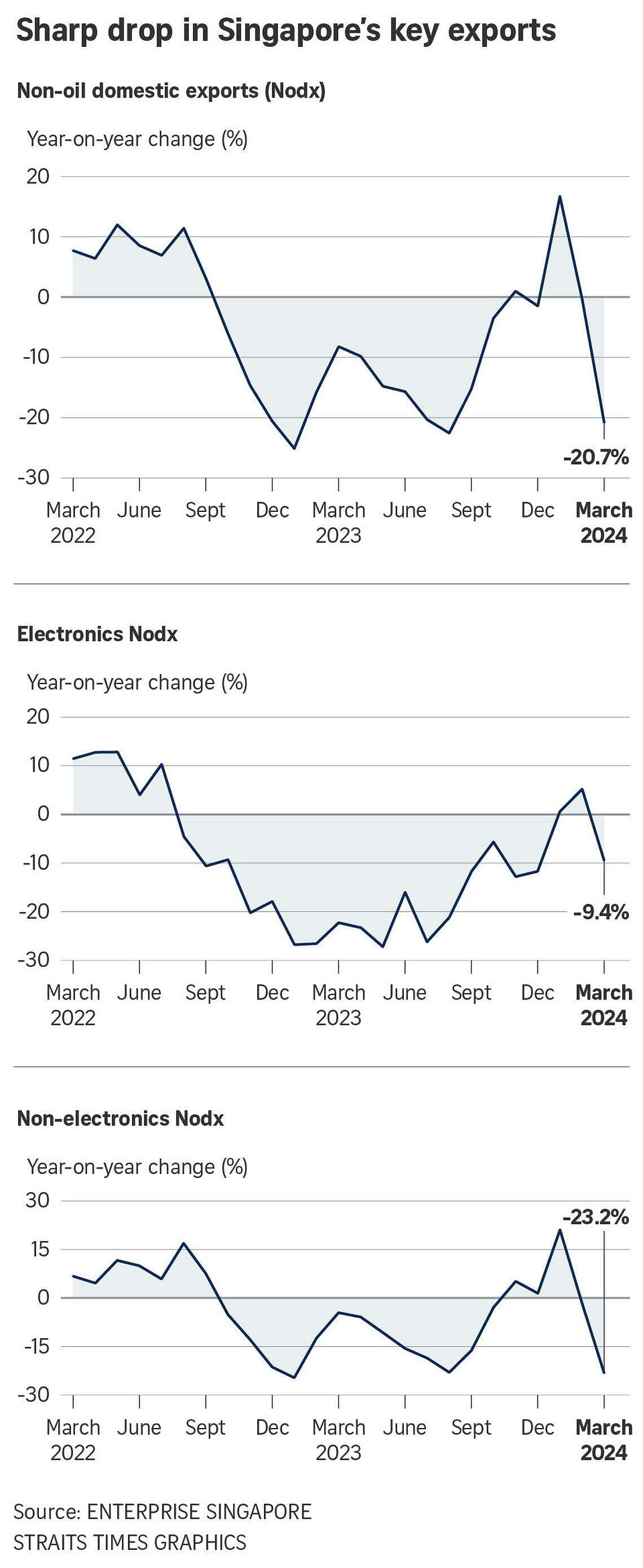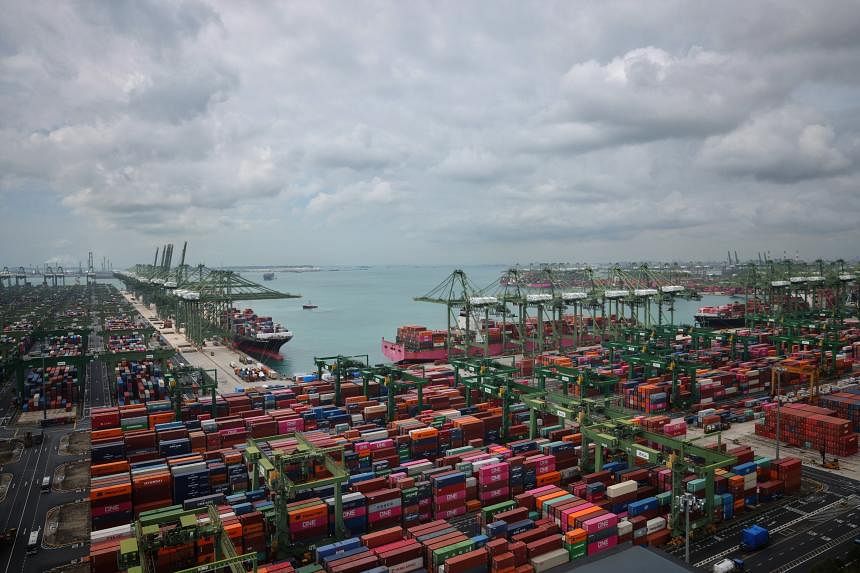SINGAPORE – The latest report card on Singapore’s trade performance released on April 17 has economists sounding warnings on the export outlook and pointing to weakness in the key semiconductor industry.
Non-oil domestic exports (Nodx) shrank 20.7 per cent in March, a steeper contraction than February’s revised 0.2 per cent decline, albeit from a high base a year ago.
But the drop was also much worse than the 7.4 per cent fall forecast by analysts in a Bloomberg poll.
Trade agency Enterprise Singapore (EnterpriseSG) said the steep fall in exports was driven largely by non-electronics, which includes pharmaceutical shipments, though electronics shipments also dropped.
For the first quarter, Nodx fell by a larger 3.4 per cent compared with the 1.4 per cent drop seen in the fourth quarter of 2023.
The data confirms expectations that Singapore’s external sector stalled in the first quarter, said Mr Shivaan Tandon, an economist at Capital Economics.
Non-electronics Nodx contracted by 23.2 per cent in March from a year ago, extending the 1.7 per cent decline in February.
Shipments from the pharmaceutical segment sank 70.3 per cent ($2.1 billion), snapping a five-month growth streak, while exports of ship and boat structures slid 99.8 per cent ($900 million), contributing to the sharp declines in non-electronics shipments.
Mr Khoon Goh, head of Asia research at ANZ, said he is not concerned about the “big dive in pharmaceutical exports” because the category is “very volatile”. He expects pharmaceuticals to rebound in the coming months.
He is more disappointed about the weakness of electronics exports, particularly for integrated circuits (ICs), also referred to as chips or semiconductors.
Year on year, electronics exports resumed their decline, falling by 9.4 per cent in March, snapping two months of expansion in February (5.2 per cent) and January (0.6 per cent).
Telecommunications equipment, ICs, and diodes and transistors contributed the most to the drop.
Telecommunications equipment fell by 38.8 per cent ($100 million), diodes and transistors by 11 per cent, and ICs – which formed about half of electronics Nodx – gave up 8 per cent ($100 million).
ICs are a vital component of various electronic devices. ANZ had expected the IC segment to do better, as it rode on the upswing in the global semiconductor cycle.
“Singapore is definitely lagging behind South Korea and Taiwan in a big way,” Mr Goh added.
Capital Economics’ Mr Tandon said South Korea and Taiwan are benefiting from robust demand for high-end memory chips and chips used in artificial intelligence servers.
He added that while Singapore will benefit from an uptick in demand in the electronics sector, “the gains are limited compared to those for South Korea and Taiwan”.
On a more upbeat note, DBS economist Chua Han Teng said the ongoing expansion in new export orders for the headline and electronics manufacturing purchasing managers’ indexes suggests that Singapore’s overseas shipments should see better prospects in 2024.
Overall new export orders rose for the sixth straight month in March, while those for electronics climbed for the fourth consecutive month, Mr Chua said.
The new export orders readings track foreign demand for Singapore’s goods and services.
On a month-on-month seasonally adjusted basis, which removes the effects of seasonal variations in the numbers, Nodx fell by 8.4 per cent in March, sharper than the 4.9 per cent decline in February.
In value terms, March Nodx came to $13 billion, lower than the previous month’s $14.2 billion and the year-ago level of $15.7 billion.
By markets, shipments to Singapore’s top 10 markets fell, with the main hits coming from the United States, the European Union and Japan.

Shipments of pharmaceuticals and structures of ships and boats led to the 50.2 per cent decline in exports to the US.
Nodx to the EU contracted by 45.4 per cent, due also to pharmaceuticals, specialised machinery and telecommunications equipment.
But Nodx to China grew 11.9 per cent in March, after falling 0.1 per cent in the previous month. Hong Kong (16.5 per cent growth) and Taiwan (2 per cent growth) were also bright spots.
Mr Goh expects shipments to China to grow due to low base effects from 2023 and the improving Chinese economy. Official data on April 16 showed the Chinese economy grew at a faster-than-expected pace of 5.3 per cent year on year in the first quarter of 2024.
Mr Tandon is not as optimistic, saying he expects the Chinese economy to enter a “renewed slowdown in the second half of the year”. This will keep a lid on exports from Singapore, he said.
He added that weaker global growth, driven by the “fading resilience of the US economy”, will weigh on Singapore’s export-oriented economy in the coming quarters.
EnterpriseSG had forecast in February that Singapore’s exports would grow by 4 per cent to 6 per cent in 2024, up from its November projection of a 2 per cent to 4 per cent increase.
Mr Chua said ongoing global uncertainties could contribute to a fragile exports recovery. Downside risks could come from regional conflicts, geopolitical tensions and uncertainty over economic policy, he said.


